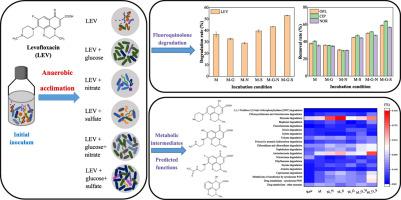Journal of Hazardous Materials ( IF 12.2 ) Pub Date : 2021-02-24 , DOI: 10.1016/j.jhazmat.2021.125520 Wenhui Shu , Yan Zhang , Donghui Wen , Qinyue Wu , He Liu , Min-hua Cui , Bo Fu , Jie Zhang , Ye Yao

|
For improving the understanding of anaerobic degradation mechanism of fluoroquinolone antibiotics (FQs), the degradation of a representative FQs, levofloxacin (LEV), by six enriched anaerobic consortia were explored in this study. The effect of sulfate and nitrate as the electron acceptor and glucose as the carbon source on LEV anaerobic degradation were investigated. Addition of glucose and nitrate alone deteriorated LEV removal from 36.5% to 32.7% and 29.1%, respectively. Addition of sulfate slightly improved LEV removal to 39.6%, while simultaneous addition of glucose and sulfate significantly enhanced LEV removal to 53.1%. Twelve biodegradation intermediates were identified, which indicated that cleavage of piperazine ring is prior to that of quinolone ring, and hydroxylation, defluorination, demethylation, and decarboxylation were the primary steps of LEV anaerobic degradation. Lactobacillus, unclassified _f_Enterobacteriaceae, and Bacillus were enriched by simultaneous addition of glucose and sulfate, with relative abundance of 63.5%, 32.7%, and 3.3%, respectively. The predicted high gene abundance of xenobiotics biodegradation & metabolism, carbohydrate metabolism, and assimilatory sulfate reduction in the consortium, indicated a co-metabolism between carbohydrate metabolism, sulfate metabolism, and LEV degradation under glucose and sulfate added condition. The study revealed that simultaneous addition of glucose and sulfate is the favorable condition for LEV anaerobic degradation.
中文翻译:

富集微生物群落对左氧氟沙星的厌氧生物降解:电子受体和碳源的影响
为了增进对氟喹诺酮类抗生素(FQs)厌氧降解机理的了解,本研究探索了由六个富集的厌氧菌群对代表性FQs左氧氟沙星(LEV)的降解。研究了硫酸盐和硝酸盐作为电子受体,葡萄糖作为碳源对LEV厌氧降解的影响。单独添加葡萄糖和硝酸盐会使LEV去除率分别从36.5%降至32.7%和29.1%。加入硫酸盐可将LEV去除率略微提高至39.6%,而同时添加葡萄糖和硫酸盐则可将LEV去除率明显提高至53.1%。鉴定了十二种生物降解中间体,这表明哌嗪环的裂解先于喹诺酮环的裂解,并且羟基化,脱氟,脱甲基,乳酸菌,未分类的肠杆菌科细菌和芽孢杆菌通过同时添加葡萄糖和硫酸盐而富集,相对丰度分别为63.5%,32.7%和3.3%。预测的生物外源生物降解和代谢,碳水化合物代谢和同化硫酸盐还原的高基因丰度表明,在添加葡萄糖和硫酸盐的条件下,碳水化合物代谢,硫酸盐代谢和LEV降解之间存在共代谢。研究表明,同时添加葡萄糖和硫酸盐是LEV厌氧降解的有利条件。









































 京公网安备 11010802027423号
京公网安备 11010802027423号